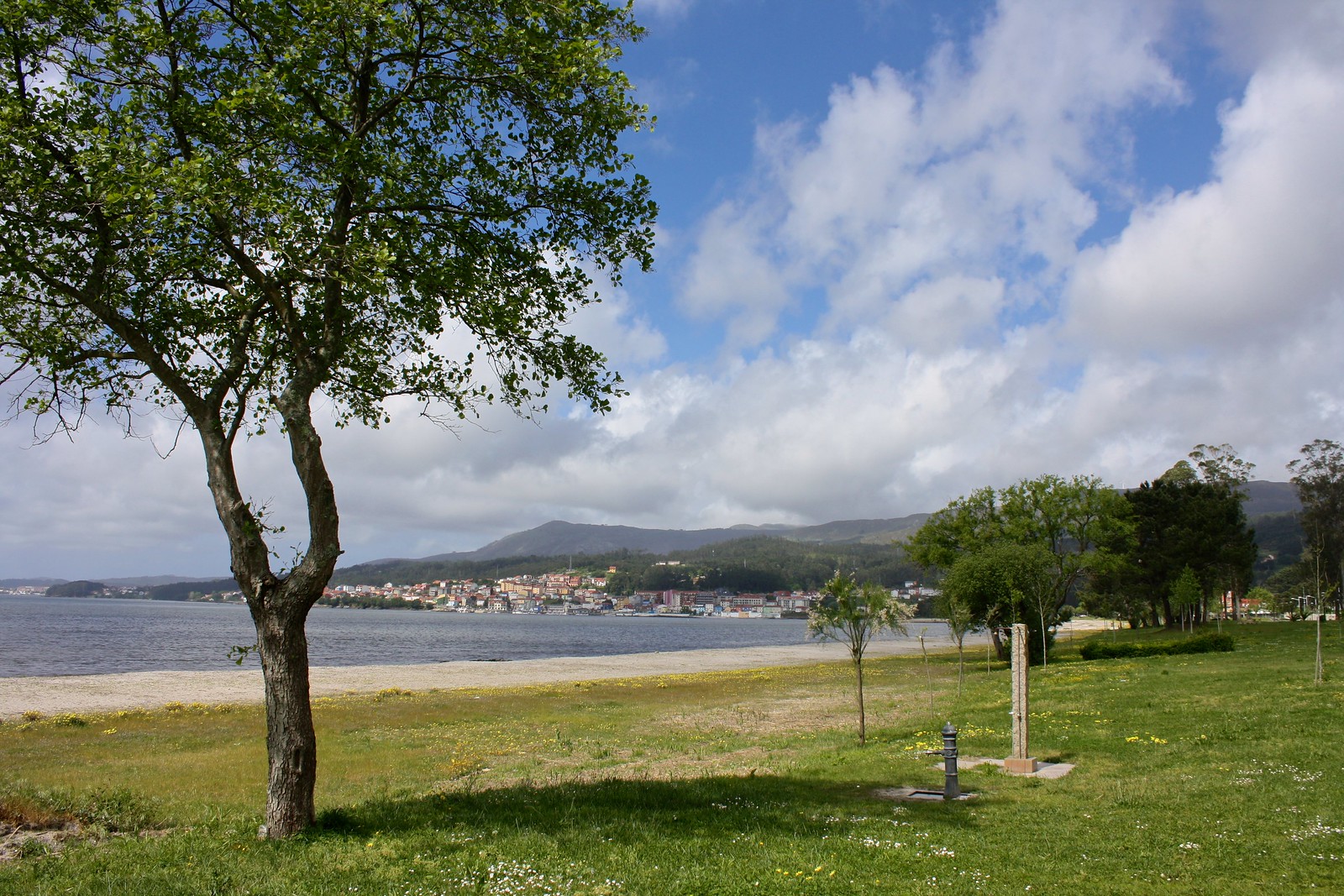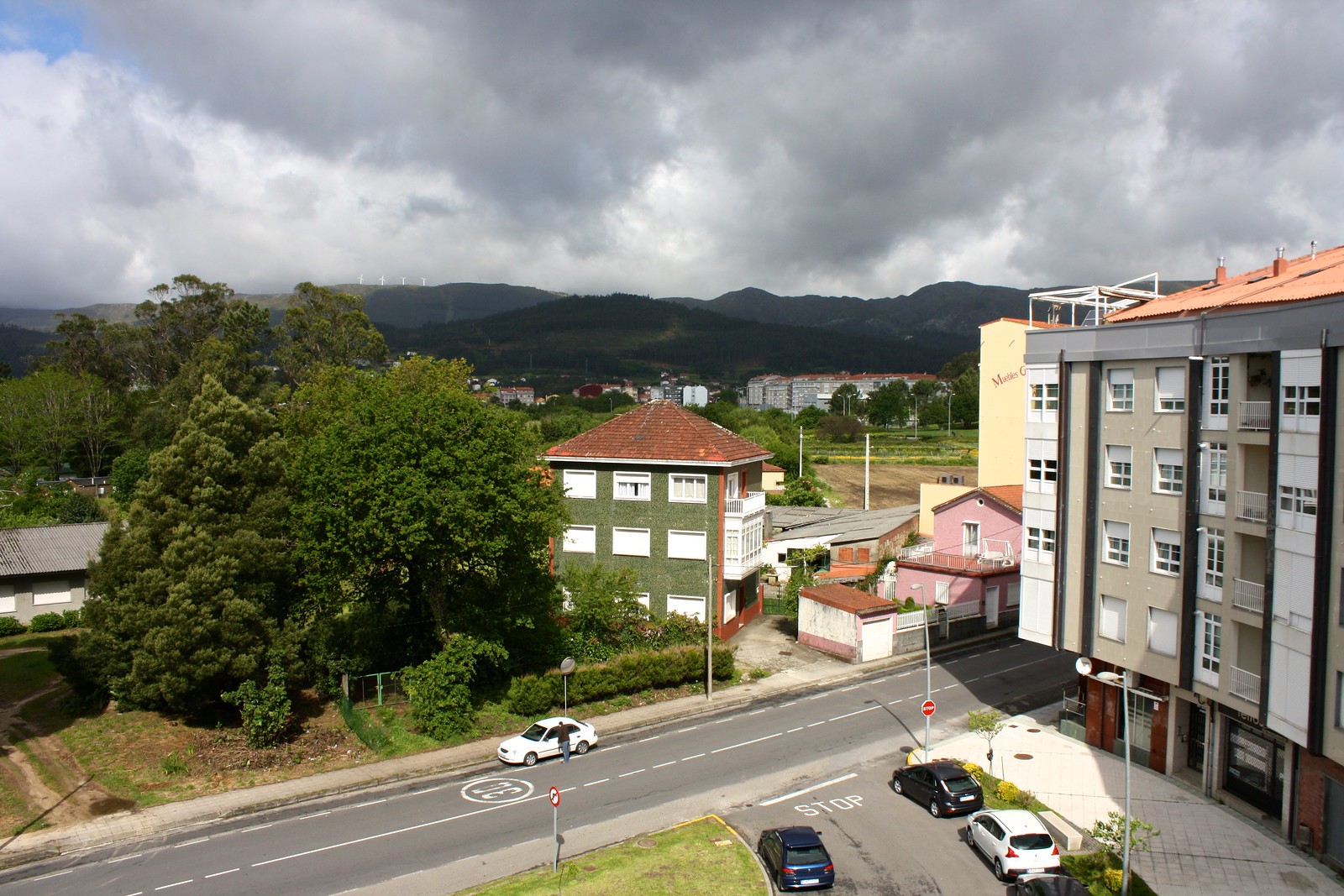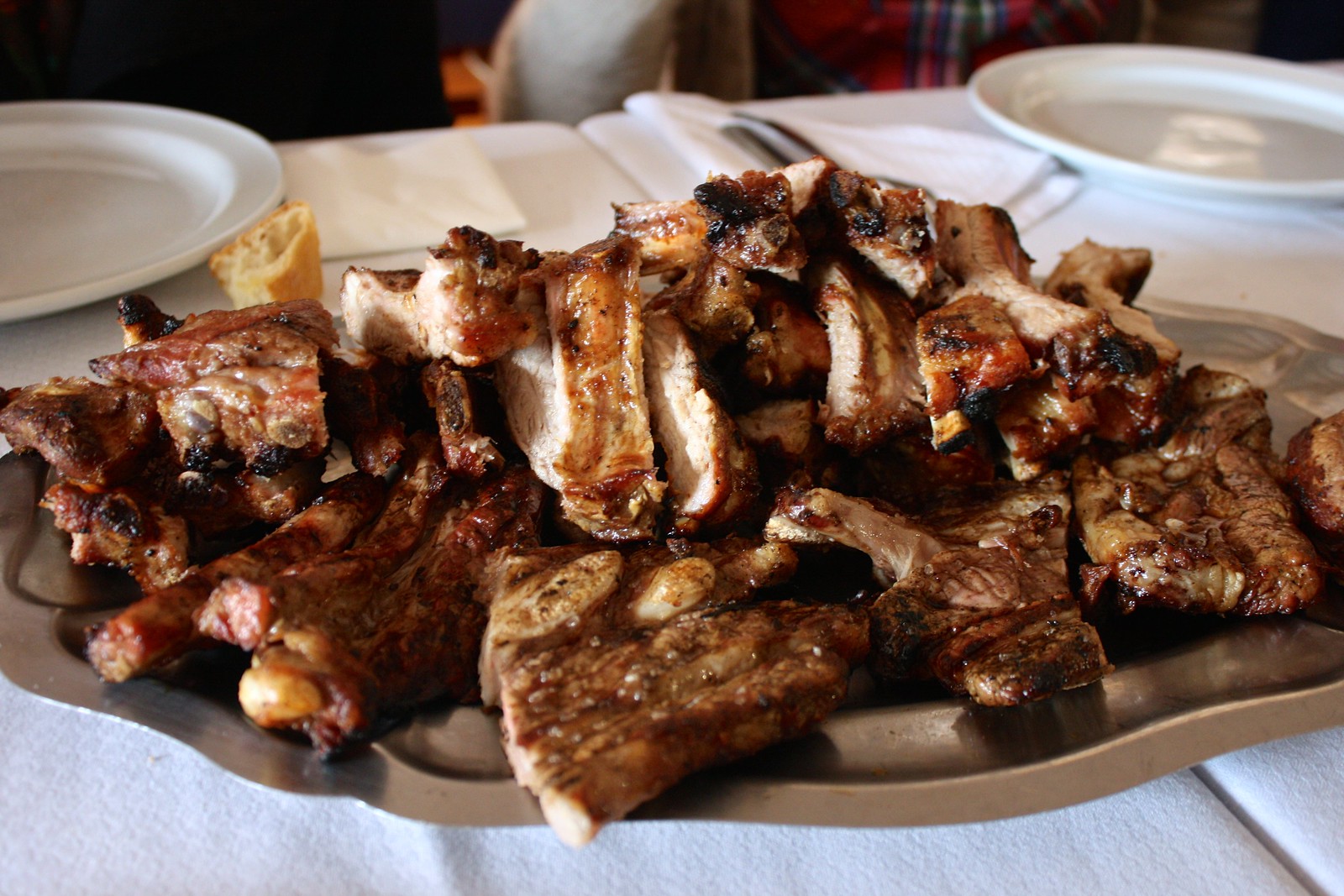Boiro, Spain: A Typical Galician Coastal Town
Before I got placed to teach English at a rural elementary school in a village called Abanqueiro, I knew very little about the western coasts of Galicia, Spain’s northwestern region. Although I knew I was going to work in Abanqueiro, the address that my placement letter gave me included “Boiro” in parentheses, something that really threw me off. Was my school in Abanqueiro or Boiro?
Both, actually. Come to find out, the population in Spain’s northern regions is distributed a lot differently than it is down south. Whereas in Andalucía, you have a tight, compact urbanization that belongs to a single municipio (municipality) with virtually no “settlements” outside the city limits (that’s where all the olive groves are, silly!), in Galicia, things are a lot more spread out.
The whole region is broken down into various concellos (municipalities), each with their own town hall in the main city center. Each concello is divided into several administrative parroquias or parishes, since so many people have their own homes and family farms scattered around the built-up core. So the concello of Boiro was, indeed, where I was destined to work. Abanqueiro, the rural parroquia my school was in, was just a five-minute drive south from downtown Boiro.
I’ll talk more about Abanqueiro—the village and the school—later this week. But right now, I want to talk about the urban setting of Boiro, which I think is a typical Galician coastal town.
There’s little historic core to speak of, maybe a stone house here and a Baroque chapel there, because most of the Boiro you see today was constructed in the past ten years or so during Spain’s big construction bubble. The modern city center follows a spacious grid layout, with plain granite apartment façades peeking over shops, restaurants, businesses, and empty lots. A brand-new, white town hall commands an austere praza or central square where kids play on a playground and old men pick up the daily newspaper.
Boiro’s main industry has to do with seafood caught from the ría or inlet of the sea that laps at the beach just minutes from town. The Ría de Arousa provides locals millions of mussels, which are grown and harvested on floating structures called bateas. These and other shellfish often get taken to factories where they’re cooked, canned, and sent off to the rest of the country and the world.
But Boiro’s coastal setting isn’t just a dreamland for pescatarians. Beach bums will be glad to hear that the town has a grand beach that stretches for kilometers on the western edge of the peninsula, Praia Xardín. This “garden beach” has spacious vistas of A Pobra do Caramiñal and Ribeira along the coast and the Atlantic Ocean further in the distance. In both summer and winter, you can appreciate beautiful views by going on a walk along the Paseo Marítimo.
If we’re being honest, I never really spent that much time in Boiro since I always carpooled to and from work directly with other teachers. With no car, Abanqueiro was a good half-hour walk from downtown Boiro. And I wasn’t in favor of taking the expensive, long, and nausea-inducing bus ride from Santiago just to check out the town every now and then. One weekend in April, I did come for a proper visit, and when I went out for dinner with all of the local language assistants, they were so surprised to finally meet me, the town’s “mystery auxiliar” after seven months in the program.
Like any Galician city worth its (sea) salt, Boiro is home to dozens of bars, cafés, and restaurants all serving a variety of food, mainly coffee and traditional Galician cooking. Every Tuesday during our two-hour lunch break, a few of the teachers and I would go to a restaurant in town and order off the menú del día, or daily set menu which included a drink, bread, a first course (often soup, salad, or something vegetarian), a second course (mainly meat or fish and potatoes), coffee, and dessert—for just 10€! As the school year went on, we became creatures of habit and almost exclusively patronized Don Paquito’s, but not before I got a chance to taste a selection of some decent places to grab a bite to eat in Boiro.
Restaurante Asador Arume (Avenida de Compostela, Nº 30)
We came here for dinner my first week in town: a classy, yet, affordable establishment on the west side of town that serves quality Galician food like steamed mussels, barbecue ribs, or boiled octopus. The name arume is the Galician word for “pine needles,” a common sight along the forested western coasts.
D’Pinchos (Rúa de Robustiano Pérez del Río, Nº 5)
This casual, cozy restaurant in the city center is Boiro’s answer to Chili’s: a trendy joint where you can get anything from hamburgers and chicken wings to octopus and paella. As their name would suggest, they offer a wide selection of pinchos or canapés of bread with little bites of this or that on top, and they also have a promotional card where if you get nine 10€ menús del día, you get your tenth meal free.
Trattoria Roma (Rúa Bao, Nº 16)
If you’re craving Italian food (and let’s be honest, by that, we all mean PIZZA), this is Boiro’s place to get it in an admittedly stark interior. If you come here for the lunch menú del día, be prepared to receive a massive, entire pizza if you order it for your second course—but no worries, ’cause they’ll let you box up the half you don’t eat.
Café Bar A Capilla (Rúa Principal, Nº 76)
A Capilla is a great place to fill up at when you hop off the bus from Santiago in front of the town hall; it’s mere feet from the bus stop which means you don’t have to run far if it’s (most likely) pouring down rain. I like A Capilla because they serve gargantuan sandwiches on the cheap: an entire loaf of bread, sliced down the middle, stuffed with tortilla (potato omelet), grilled pork loin, or (my personal favorite) fried calamari and aioli sauce.
La Taza de Pandora (Rúa de Norberto Pizjuán, Nº 5)
There is a time and a place for old-man bars that boast grumpy baristas, shiny stainless steel counters, and quality toast and churros. When you’re in the mood for something more along the lines of a coffee house, check out this café, which means “Pandora’s Cup” in Spanish. The warm interior has a variety of seating options, a playplace for the kids, and lots of big-screen TVs for watching the latest soccer game. What really impressed me about La Taza (just down the hill from the town hall) is that they serve smooth, quality coffee roasted by A Coruña-based Cafés Siboney, not any of that harsh torrefacto stuff you’ll find in many other Spanish cafés.
Restaurante Don Paquito
Although not in central Boiro—it’s in Escarabote, about a 20-minute walk along the beachfront esplanade from the city center—Don Paquito’s consistently served up quality food, with good service, at a decent price. For only 10€, the menú del día includes your drink, baskets of bread, a first course (like tripe + chickpea stew or a mixed salad), a second course (think barbecue pork ribs or fish caught in the ría), dessert, and coffee. I spent many a cold, rainy winter Tuesday afternoon warming up with a bottomless bowl of stew and crusty bread and always looked forward to the sobremesa or after-dinner conversation over a café con leche and cake.
Have you ever been to Boiro or one of the many fishing villages along Galicia’s Rías Baixas? What restaurant would you pick off of my list of recommendations? Tell me in the comments below!

 |
| Boiro, seen from my plane window! |
Both, actually. Come to find out, the population in Spain’s northern regions is distributed a lot differently than it is down south. Whereas in Andalucía, you have a tight, compact urbanization that belongs to a single municipio (municipality) with virtually no “settlements” outside the city limits (that’s where all the olive groves are, silly!), in Galicia, things are a lot more spread out.
The whole region is broken down into various concellos (municipalities), each with their own town hall in the main city center. Each concello is divided into several administrative parroquias or parishes, since so many people have their own homes and family farms scattered around the built-up core. So the concello of Boiro was, indeed, where I was destined to work. Abanqueiro, the rural parroquia my school was in, was just a five-minute drive south from downtown Boiro.
I’ll talk more about Abanqueiro—the village and the school—later this week. But right now, I want to talk about the urban setting of Boiro, which I think is a typical Galician coastal town.
Introducing Boiro
 |
| Church of Santa Baia |
There’s little historic core to speak of, maybe a stone house here and a Baroque chapel there, because most of the Boiro you see today was constructed in the past ten years or so during Spain’s big construction bubble. The modern city center follows a spacious grid layout, with plain granite apartment façades peeking over shops, restaurants, businesses, and empty lots. A brand-new, white town hall commands an austere praza or central square where kids play on a playground and old men pick up the daily newspaper.
Boiro’s main industry has to do with seafood caught from the ría or inlet of the sea that laps at the beach just minutes from town. The Ría de Arousa provides locals millions of mussels, which are grown and harvested on floating structures called bateas. These and other shellfish often get taken to factories where they’re cooked, canned, and sent off to the rest of the country and the world.
 |
| Xardín Beach |
But Boiro’s coastal setting isn’t just a dreamland for pescatarians. Beach bums will be glad to hear that the town has a grand beach that stretches for kilometers on the western edge of the peninsula, Praia Xardín. This “garden beach” has spacious vistas of A Pobra do Caramiñal and Ribeira along the coast and the Atlantic Ocean further in the distance. In both summer and winter, you can appreciate beautiful views by going on a walk along the Paseo Marítimo.
If we’re being honest, I never really spent that much time in Boiro since I always carpooled to and from work directly with other teachers. With no car, Abanqueiro was a good half-hour walk from downtown Boiro. And I wasn’t in favor of taking the expensive, long, and nausea-inducing bus ride from Santiago just to check out the town every now and then. One weekend in April, I did come for a proper visit, and when I went out for dinner with all of the local language assistants, they were so surprised to finally meet me, the town’s “mystery auxiliar” after seven months in the program.
Where to eat
 |
| Pedestrianized street with terraces for sipping a coffee at |
Like any Galician city worth its (sea) salt, Boiro is home to dozens of bars, cafés, and restaurants all serving a variety of food, mainly coffee and traditional Galician cooking. Every Tuesday during our two-hour lunch break, a few of the teachers and I would go to a restaurant in town and order off the menú del día, or daily set menu which included a drink, bread, a first course (often soup, salad, or something vegetarian), a second course (mainly meat or fish and potatoes), coffee, and dessert—for just 10€! As the school year went on, we became creatures of habit and almost exclusively patronized Don Paquito’s, but not before I got a chance to taste a selection of some decent places to grab a bite to eat in Boiro.
Restaurante Asador Arume (Avenida de Compostela, Nº 30)
We came here for dinner my first week in town: a classy, yet, affordable establishment on the west side of town that serves quality Galician food like steamed mussels, barbecue ribs, or boiled octopus. The name arume is the Galician word for “pine needles,” a common sight along the forested western coasts.
 |
| View from the western edge of town |
D’Pinchos (Rúa de Robustiano Pérez del Río, Nº 5)
This casual, cozy restaurant in the city center is Boiro’s answer to Chili’s: a trendy joint where you can get anything from hamburgers and chicken wings to octopus and paella. As their name would suggest, they offer a wide selection of pinchos or canapés of bread with little bites of this or that on top, and they also have a promotional card where if you get nine 10€ menús del día, you get your tenth meal free.
Trattoria Roma (Rúa Bao, Nº 16)
If you’re craving Italian food (and let’s be honest, by that, we all mean PIZZA), this is Boiro’s place to get it in an admittedly stark interior. If you come here for the lunch menú del día, be prepared to receive a massive, entire pizza if you order it for your second course—but no worries, ’cause they’ll let you box up the half you don’t eat.
Café Bar A Capilla (Rúa Principal, Nº 76)
A Capilla is a great place to fill up at when you hop off the bus from Santiago in front of the town hall; it’s mere feet from the bus stop which means you don’t have to run far if it’s (most likely) pouring down rain. I like A Capilla because they serve gargantuan sandwiches on the cheap: an entire loaf of bread, sliced down the middle, stuffed with tortilla (potato omelet), grilled pork loin, or (my personal favorite) fried calamari and aioli sauce.
La Taza de Pandora (Rúa de Norberto Pizjuán, Nº 5)
There is a time and a place for old-man bars that boast grumpy baristas, shiny stainless steel counters, and quality toast and churros. When you’re in the mood for something more along the lines of a coffee house, check out this café, which means “Pandora’s Cup” in Spanish. The warm interior has a variety of seating options, a playplace for the kids, and lots of big-screen TVs for watching the latest soccer game. What really impressed me about La Taza (just down the hill from the town hall) is that they serve smooth, quality coffee roasted by A Coruña-based Cafés Siboney, not any of that harsh torrefacto stuff you’ll find in many other Spanish cafés.
 |
| Barbecue ribs at Don Paquito’s |
Restaurante Don Paquito
Although not in central Boiro—it’s in Escarabote, about a 20-minute walk along the beachfront esplanade from the city center—Don Paquito’s consistently served up quality food, with good service, at a decent price. For only 10€, the menú del día includes your drink, baskets of bread, a first course (like tripe + chickpea stew or a mixed salad), a second course (think barbecue pork ribs or fish caught in the ría), dessert, and coffee. I spent many a cold, rainy winter Tuesday afternoon warming up with a bottomless bowl of stew and crusty bread and always looked forward to the sobremesa or after-dinner conversation over a café con leche and cake.
How to get there
You can either drive here or take the Arriva bus from Santiago de Compostela, which stops at Padrón along the way and drops you off in front of the town hall. You can buy your ticket on the bus, but make sure you have change because the drivers get grumpy if you hand them a 20€ note.Have you ever been to Boiro or one of the many fishing villages along Galicia’s Rías Baixas? What restaurant would you pick off of my list of recommendations? Tell me in the comments below!
